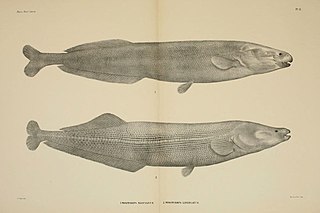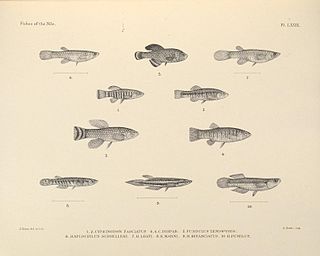
Sarotherodon is a genus of oreochromine cichlids that are native to the northern half of Africa, with a single species, S. galilaeus, also ranging into the Levant. A couple of species from this genus have been introduced far outside their native range, and are important in aquaculture. Most other species have small ranges and some are seriously threatened. They mainly inhabit fresh and brackish water, but a few can live in salt water. Species in this genus, as well as those in several other oreochromine and tilapiine genera, share the common name "tilapia" and historically they were included in the genus Tilapia.

Synodontis is the largest genus of mochokid catfishes. It is the biggest genus within the 10 genera and 190 different species in the family Mochokidae. Synodontis has over 131 different species within the genus. Synodontis are also known as squeakers, due to their ability to make stridulatory sounds through their pectoral fin spines when handled or disturbed. Synodontis make a sound that sounds like squeaking by rubbing their spines together. They do this when they have been frightened or when they become angry. Synodontis may also squeak when they are taken out of the water. These catfish are small- to medium-sized fish with many species exhibiting attractive spotted markings. Some species are also known for naturally swimming belly-up, earning the name upside-down catfish. Some of these species are Synodontis contractus and Synodontis nigriventris. While some of these species are known to swim upside down, another species, Synodontis multipunctatus, is a brood parasitic cuckoo catfish,there are two other species Synodontis petricola and Synodontis grandiops are also called brood parasitic cuckoo catfish.

The banded lampeye is a species of poeciliid that is native to Africa, ranging from Senegal to Angola. It is mainly found in coastal brackish habitats such as river mouths, lagoons and mangrove swamps. It reaches up to 7 cm (2.8 in) in total length.
Hypsopanchax is a genus of poeciliids native to freshwater habitats in Middle Africa.

Pantanodon is a genus of poeciliids native to East Africa and Madagascar.

Mormyrops is a genus of weakly electric fish in the family Mormyridae from freshwater in Africa. They are characterized by an elongate head measuring twice as long as high, and no teeth on the palate or the tongue. The genus includes the largest member of the mormyrid family, the cornish jack at up to 1.5 m (4.9 ft) in length.
Enteromius collarti is a species of ray-finned fish in the genus Enteromius which is only found in Angola.
Enteromius evansi is a species of ray-finned fish in the genus Enteromius from the Catumbela and Kwanza river systems in Angola.
Enteromius prionacanthus is a species of ray-finned fish in the genus Enteromius which is endemic to Gabon.
Enteromius wellmani is a species of ray-finned fish in the genus Enteromius which is only found in the upper reaches of the Cuvo River system in Angola.
The butterfly barb is a species of cyprinid fish in the genus Enteromius.

Leptocypris is a genus of cyprinid fish found in Africa. There are currently nine recognized species in this genus.

Citharinus is a genus of lutefishes from tropical Africa, with six currently described species:
Lacustricola is a genus of poeciliids native to East, Southern and Middle Africa.

Micropanchax is a genus of poeciliids native to Africa.
Plataplochilus is a genus of poeciliid fishes native to Middle Africa.

Poropanchax is a genus of small poeciliid fishes native to Africa.
Procatopus is a genus of poeciliid fishes native to tropical freshwater habitats in Cameroon and Nigeria.

Enteromius is a genus of small to medium-sized cyprinid fish native to tropical Africa. Most species were placed in the genus Barbus.
Aapticheilichthys is a monotypic genus of killifish from the family Poeciliidae, the sole member being Aapticheilichthys websteri. A. websteri was found by the American fish breeder Kent Webster after which the species was named. The type locality was Akaka Camp on the western coastal plain of Gabon. A. websteri was collected from a river that was less than 10m wide on the night of the Asian tsunami, though it is not clear what effect of the tsunami may have had on the local ecosystem.









